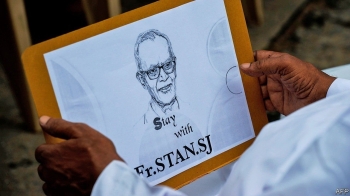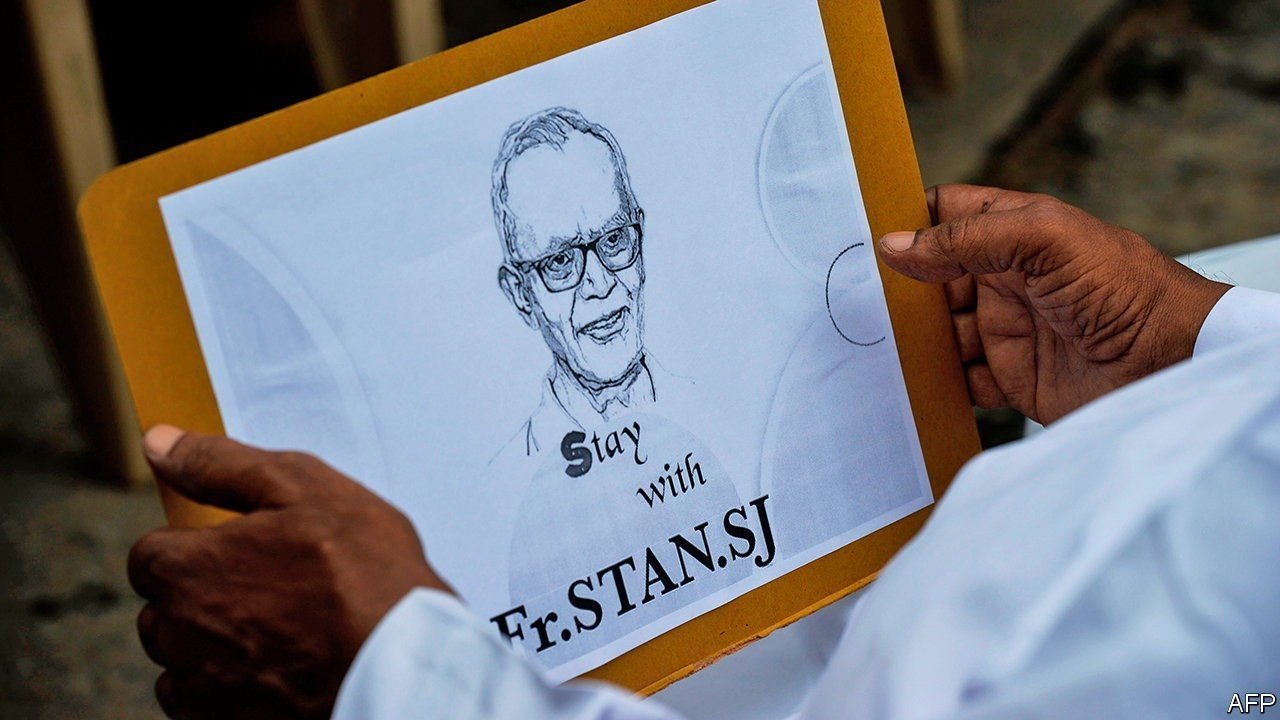
.png) Albert Thyrniang
Albert Thyrniang

Following the custodial death of the 84-year-old Father Stanislaus Lourduswamy, the last issue of the Indian Currents described the crusader of the Adivasi rights as a ‘martyr’, a ‘modern saint’, a ‘prophet’, and a ‘good shepherd’. The issue contained stories on the humble priest from a small village whose crusading works have now become part of the Adivasi folklore. When the rights activist was arrested in October last, the weekly had expressed outrage; it had called on every Indian to “awake, arise and speak out” against the revengeful action of the state. Among the mainstream media, the Frontline magazine (July 17-30) has a detailed story recounting how the priest was silenced in death and was victim of a witch-hunt by the state that is solely responsible for his demise.
The passing away of the Parkinson patient on July 5 in hospital after being treated inhumanly in jail and denied repeated bails in spite of his deteriorating health sparked fury and grief in the country and abroad. The Central Government and the National Investigation Agency (NIA) came under severe criticism for the alleged ‘false charges’ implicating the activist in the Elgar Parishad or Bhima-Koregaon violence and slapping him with sedition under the ‘draconian’ Unlawful Activities (Prevention) Act 1963 for having ‘Maoist’ links.
Father Stan, one among a long line of Jesuit Priests who toiled to empower the Adivasis, did commendable works in questioning the non-implementation of the Fifth Schedule of the Constitution under which the land belongs to the Scheduled Tribes (STs). His activism is credited for reminding the government that the Fifth Schedule stipulates the setting up of Tribes Advisory Councils which should administer and control tribal land. Father Stan challenged this violation and was disgusted that even the rules for Fifth Schedule were not being framed; hence forest and cultivable lands were being acquired for dams and industrial purposes without the consent of the villagers and with minimal compensation.
We salute Father Stan and other rights activists for paving the ground for the passage of the Panchayats (Extension to Scheduled Areas) Act (PESA) by Parliament in 1996 ensuring that the Government of India entrusts the governance of Scheduled Areas with the traditional Gram Sabhas and grants them power to administer their lands and forests. With this law in effect, Central and state governments and private players could no longer take advantage of the “disempowered” tribals. This obviously upset the influential industrialists and powerful mining lobbies.
The tribal community is indebted to Father Stan for his crusading work in favour of the Land Acquisition Act, 2013 or the Right to Fair Compensation and Transparency in Land Acquisition that lays down the procedures and rules for granting compensation, rehabilitation and resettlement to the affected persons. Father Stan actively campaigned for the Act and was enthusiastically involved in spreading awareness among the affected people to claim their rightful dues even if they lose their land to the government or private companies.
Father Stan’s effort got a boost with the Supreme Court’s verdict of July 2013 that states that the ‘owner of the land is also owner of the sub-soil/mineral wealth’ and that ownership of such resources are not with the government. Swamy organised the tribals to assert themselves citing this favourable Apex Court judgment.
Another action that might have threatened governments, the police and the administration was the filing of the Public Interest Litigation (PIL) in the Jharkhand High Court detailing that the 3000 Adivasi youths languishing in jails for years deserve a speedy trial. Prior to the PIL, Swamy had conducted a detailed and credible study of the conditions of branded ‘Naxalites’ in jails. His decision to co-found the Persecuted Prisoners Solidarity Committee (PPSC), a conglomerate of rights organisations, put Swamy under surveillance which ultimately led to his arrest and hastened his demise.
Father Stan is hailed for holding a mirror to the powerful. The mirror reflected injustice and exploitation. Everyone eyes the wealth in the Adivasi belt but neglects the people. Since he was a Catholic Priest it is perhaps apt to relate to the Church as well. The tragic death of a member of the Society of Jesus (SJ) challenges the Church. The soft spoken soul held a mirror to the Church too. The images from the mirror are the silence and inequality in the Church. The Church has not been forthright on social, political and economic issues that affect the less privileged. In a story someone grimly observed, “The Jesuit priest battled for the underprivileged as a lonesome rider on a lonesome road.”
Outspoken individuals of the calibre of Father Stan are on the decline. The Church does not encourage daring activists. The Church prefers ‘prudence’ rather than being a martyr. Father Stan asks us today: How many of the current Church leaders have been vocal on constitutional rights of the Dalits, Adivasis, tribals, minorities and the under privileged? Why is the Church leadership silent against hate, intolerance, communalism, religious bigotry and the dangers from right wing ideology? Has the Church made known its defence of the constitutional principles and values like secularism, pluralism and tolerance whenever they come under attack? It is too evident that the Church has been found wanting particularly during the present regime? Will the Church raise another Stan Swamy? Will he/she get the backing if someone was to follow the footsteps of Stan Swamy?